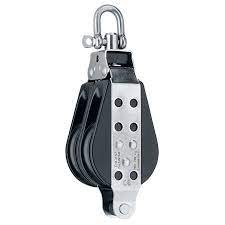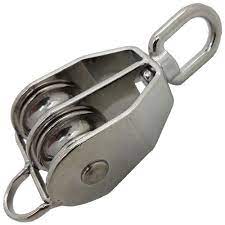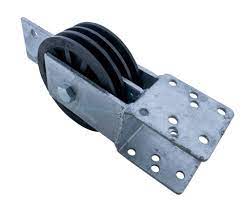Product Description
Stainless Steel SS304 Hardware Rigging wire rope rolling bearing block pulley
| Item | Wire Rope Pulley |
| Model | Single Pulley, Double Pulley |
| Size | M15-M100 |
| Material | Stainless Steel 304/316, Carbon Steel |
| Standard | DIN, ASME, BS, JIS, AS, EN, GB for option |
| Grade | A2-70, A4-80, 4.8/8.8 |
| Finish | Plain, Passivation, Polishing, Galvanized, Zinc Plated, Hot-dip Galvanized |
| Delivery Time | 3-15 days |
| OEM | Available |
Q: What’s your product range?
A: Our product cover Bolts, Screws, Nuts, Washers, Spring ,Rivet, Anchor, Pulley, Rigging and so on.
Q: How long is your delivery time?
A: 3 days for stock items,7-15 days for production.
Q: How do you control your quality.
A: QC on-line inspection and final inspection before delivery. 6S management. MTC and Quality Report can be provide.
Q: Could you provide free samples?
A: Yes, we could offer free samples for the items in stock, just need to pay shipping cost, it can be refunded to your orders.
Q: Do you accept small order?
A: Sure, we can accept small orders if we have stock of the specification which you need..
Q: What is your packing ?
A: 20-25kg for 1 carton,36 or 48 cartons for 1 pallet. One pallets is about 900-960kg. Customized carton and Customer’s logo is available.
Q: What is your payment term?
A: We can accept T/T, L/C for bulk order. Paypal and Western Union for small order or sample order.
Made-in-China Online payment is available.
Q: Do you accept customized order?
A: Yes, we can produce according to sample or drawing.
/* January 22, 2571 19:08:37 */!function(){function s(e,r){var a,o={};try{e&&e.split(“,”).forEach(function(e,t){e&&(a=e.match(/(.*?):(.*)$/))&&1
| Warranty: | 1 Year |
|---|---|
| Type: | Wire Rope Pulley |
| Material: | Stainless Steel/Carbon Steel |
| Number of sheaves: | Single Pulley, Double Pulley |
| Control: | Manual |
| Color: | Silver |
| Samples: |
US$ 0/Piece
1 Piece(Min.Order) | |
|---|
| Customization: |
Available
| Customized Request |
|---|
Are there different types of double pulleys, and how do they vary in applications?
Yes, there are different types of double pulleys that vary in design, construction, and functionality, each with specific applications. Here is a detailed explanation of the various types of double pulleys and how they vary in their applications:
1. Fixed Double Pulleys:
– Fixed double pulleys, also known as static double pulleys, have both pulleys on a common axle or shaft, fixed in position relative to each other. These pulleys do not rotate independently of each other. Fixed double pulleys are commonly used in simple lifting or pulling applications where the direction of force remains constant. They provide mechanical advantage by dividing the load between the two pulleys and allow for efficient load movement in a single direction. Fixed double pulleys are commonly used in basic rigging setups, general lifting tasks, and simple mechanical systems.
2. Swivel Double Pulleys:
– Swivel double pulleys, also called rotating double pulleys, have pulleys that can rotate independently of each other. They are designed with a swivel mechanism that allows the pulleys to rotate around a central axis. Swivel double pulleys offer increased versatility and flexibility in rigging applications. The independent rotation of the pulleys enables rescuers or riggers to change the direction of the applied force, adjust the angle of the load, and manage complex rope configurations. Swivel double pulleys are commonly used in rescue operations, industrial rigging, rock climbing, and other applications requiring dynamic movement and directional control.
3. Tandem Double Pulleys:
– Tandem double pulleys, also known as stacked double pulleys, consist of two pulleys arranged in a tandem configuration, stacked vertically one above the other. The tandem design allows for increased mechanical advantage by creating multiple stages of pulley systems. Tandem double pulleys offer greater lifting power and are commonly used in heavy-duty rigging and lifting operations. They are ideal for scenarios where extremely heavy loads need to be lifted or pulled with reduced effort. Tandem double pulleys find applications in construction, industrial settings, and specialized lifting operations.
4. Prusik Minding Double Pulleys:
– Prusik minding double pulleys are designed with special features to accommodate the use of Prusik knots or other friction hitches. These pulleys have additional side plates or flanges that prevent the Prusik knot from jamming against the pulley body. Prusik minding double pulleys are commonly used in rescue operations and climbing systems where self-locking knots like the Prusik knot are utilized for friction-based progress capture. These pulleys allow for efficient ascending and descending while maintaining proper rope management and minimizing wear on the Prusik knot.
5. High-Efficiency Double Pulleys:
– High-efficiency double pulleys are specifically designed to minimize friction and increase overall system efficiency. They feature ball bearings or roller bearings in the pulley sheaves, reducing the friction between the rope and the pulley, thus optimizing power transmission. High-efficiency double pulleys are commonly used in scenarios where maximum mechanical advantage and minimal energy loss are critical. These pulleys find applications in rescue operations, highline systems, and any rigging setup where efficiency is paramount.
6. Compact Double Pulleys:
– Compact double pulleys are designed to be lightweight, compact, and portable without compromising strength and functionality. These pulleys are often made from lightweight materials such as aluminum or composite materials. Compact double pulleys are suitable for applications where weight and size restrictions are important, such as mountaineering, backpacking, or emergency rescue kits. They offer a balance between strength, portability, and versatility.
7. Specialty Double Pulleys:
– Specialty double pulleys encompass a range of pulleys designed for specific applications or unique requirements. These can include pulleys with specialized features like integrated progress capture mechanisms, auxiliary attachment points, or pulleys designed for specific rope diameters. Specialty double pulleys are used in specialized rescue operations, industrial rigging, and other specific scenarios where the pulley’s unique features cater to the specific needs of the operation.
In summary, different types of double pulleys, such as fixed, swivel, tandem, Prusik minding, high-efficiency, compact, and specialty pulleys, offer varying designs and functionalities. They are utilized in a wide range of applications, including general lifting, rigging operations, rescue scenarios, climbing systems, and industrial settings. Understanding the different types of double pulleys allows rescuers, riggers, and climbers to select the appropriate pulley for their specific application, optimizing performance, efficiency, and safety.
What maintenance procedures are necessary to ensure the reliability of double pulleys?
Maintenance procedures are essential for ensuring the reliability and longevity of double pulleys. Proper maintenance helps identify and address any potential issues, prevents premature wear and tear, and ensures safe and efficient operation. Here is a detailed explanation of the maintenance procedures necessary to ensure the reliability of double pulleys:
1. Regular Inspection:
– Regular visual inspections of double pulleys are necessary to detect any signs of damage, wear, or misalignment. Inspect the pulleys for cracks, deformation, or excessive wear on the pulley wheels, axle, and housing. Check for any loose or missing components such as bolts or fasteners. Inspect the ropes or cables for fraying, abrasion, or signs of damage. Regular inspections allow for early identification of potential issues and enable prompt repairs or replacements before they escalate into major problems.
2. Lubrication:
– Proper lubrication is vital for the smooth operation and longevity of double pulleys. Lubricate the pulley axles and bearings according to the manufacturer’s recommendations. Apply a suitable lubricant to reduce friction, prevent corrosion, and ensure smooth rotation of the pulley wheels. Regular lubrication helps maintain the efficiency of the pulley system and minimizes wear on the moving parts.
3. Cleaning:
– Keep the double pulleys clean and free from dirt, dust, or debris. Regularly clean the pulley wheels, axles, and housing using a suitable cleaning agent or solvent. Remove any accumulated dirt or debris that can hinder the pulley’s operation or cause premature wear. Clean ropes or cables to remove dirt or contaminants that could affect their performance or cause damage to the pulleys.
4. Tension Adjustment:
– Check the tension of the ropes or cables in the double pulley system. Ensure that they are properly tensioned according to the manufacturer’s recommendations. Overly loose or tight ropes can affect the pulley’s performance and increase the risk of failure. Adjust the tension as necessary to maintain proper operation and load-bearing capacity.
5. Replacement of Worn or Damaged Components:
– If any components of the double pulley system are worn, damaged, or nearing the end of their service life, they should be promptly replaced. This includes worn-out pulley wheels, axles, bearings, ropes, cables, or any other components that are critical for the pulley’s operation. Using worn or damaged components compromises the reliability and safety of the pulley system.
6. Load Testing:
– Periodically conduct load testing to verify the load-bearing capacity and overall performance of the double pulley system. This involves applying known loads to the system and observing its response. Load testing helps ensure that the pulleys can handle the intended loads and identify any issues related to load-bearing capacity, stability, or operation. Follow the manufacturer’s guidelines or consult with a qualified professional for proper load testing procedures.
7. Documentation and Record-Keeping:
– Maintain proper documentation and records related to the maintenance procedures performed on the double pulleys. Keep a record of inspection dates, maintenance activities, repairs, replacements, and any other relevant information. This documentation helps track the maintenance history, provides a reference for future inspections, and ensures accountability for maintenance tasks.
8. Training and Education:
– Ensure that personnel responsible for the operation and maintenance of the double pulleys are adequately trained and educated. They should be familiar with the manufacturer’s instructions, safety guidelines, and best practices for maintaining the pulleys. Ongoing training programs can help improve knowledge and skills related to pulley maintenance, promoting safe and reliable operation.
In summary, regular inspections, proper lubrication, cleaning, tension adjustment, replacement of worn or damaged components, load testing, documentation, and training are all necessary maintenance procedures to ensure the reliability of double pulleys. By following these procedures, the pulleys can be maintained in good working condition, ensuring safe and efficient operation and prolonging their service life.
Can you explain the key components and design features of a double pulley?
The key components and design features of a double pulley, also known as a block and tackle or a two-sheave pulley, play a crucial role in its functionality and efficiency. Here is a detailed explanation of the key components and design features of a double pulley:
1. Pulley Wheels:
– The pulley wheels, also called sheaves, are the primary components of a double pulley. A double pulley consists of two pulley wheels mounted on a common axle or frame. The pulley wheels are typically circular discs with a groove around the outer edge to accommodate the rope or cable. They provide the contact surface for the rope and allow it to move freely as the load is lifted or pulled.
2. Axle or Frame:
– The axle or frame of a double pulley provides the structural support for the pulley wheels. It holds the pulley wheels in place and ensures they rotate smoothly. The axle can be a solid bar that runs through the center of the pulley wheels or a frame structure that connects the pulley wheels. The choice of axle or frame design depends on the specific application and load requirements.
3. Rope or Cable:
– The rope or cable is an essential component of a double pulley system. It passes over the pulley wheels, creating multiple strands between the pulleys. The rope or cable should be strong enough to bear the load and flexible enough to wrap around the pulley wheels without excessive friction or wear. Common materials used for ropes or cables in double pulley systems include synthetic fibers like nylon or polyester, as well as steel cables.
4. Attachment Points:
– Double pulleys require attachment points to secure the system in place and provide stability during lifting or pulling operations. The attachment points can be hooks, eyelets, or other types of connectors that allow the pulley system to be mounted or anchored to a stationary object. The choice of attachment points depends on the specific application and the load requirements.
5. Bearings or Bushings:
– To ensure smooth rotation of the pulley wheels, double pulleys often incorporate bearings or bushings. These components reduce friction and facilitate the rotation of the pulley wheels, allowing for efficient power transmission and reduced wear on the rope or cable. Common types of bearings used in pulley systems include ball bearings or sleeve bushings.
6. Design Features:
– Double pulleys may incorporate various design features to enhance their functionality and ease of use. Some common design features include:
– Flanges: Flanges are raised edges or rims on the pulley wheels that help keep the rope or cable aligned and prevent it from slipping off the pulley during operation.
– Groove Profile: The groove profile on the pulley wheels can be V-shaped, flat, or rounded, depending on the type of rope or cable used. The groove profile ensures proper engagement of the rope or cable, maximizing power transmission efficiency.
– Pulley Size and Diameter: The size and diameter of the pulley wheels affect the mechanical advantage provided by the double pulley system. Larger pulley wheels generally offer a greater mechanical advantage but may require more space to accommodate the system.
– Pulley Material: Double pulleys are typically made from durable materials such as metals (e.g., steel or aluminum) or high-strength plastics. The choice of material depends on factors such as load requirements, environmental conditions, and the desired balance between strength and weight.
– Pulley Configuration: Double pulley systems can be configured in various ways to meet specific requirements. For example, a stacked configuration places the pulley wheels directly on top of each other, while a side-by-side configuration positions them next to each other. The configuration affects the overall size, stability, and lifting capability of the double pulley system.
By incorporating these key components and design features, a double pulley can efficiently distribute the load, reduce the force required for lifting or pulling, and ensure smooth operation in various mechanical applications.
editor by CX
2024-04-15




